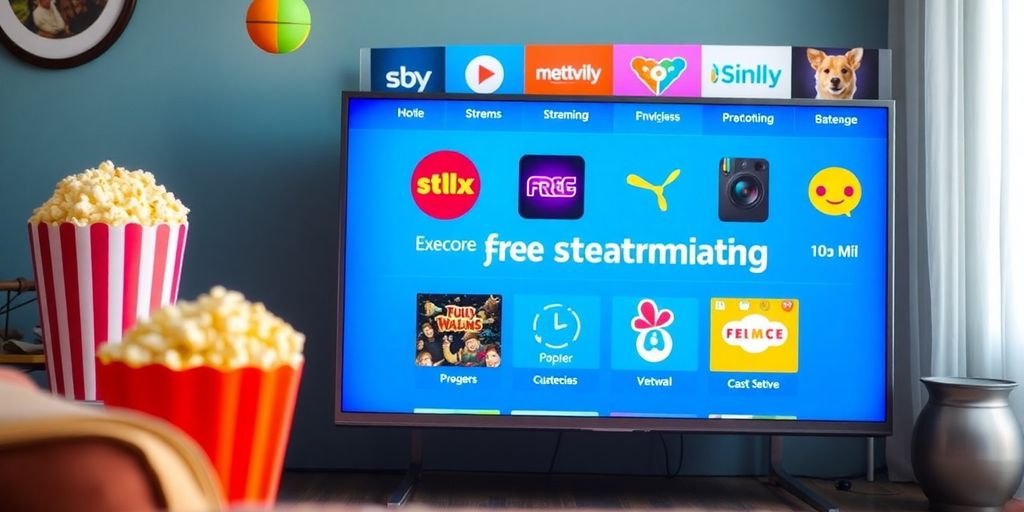As we look towards 2025, the streaming landscape is poised for significant changes. With new streaming services entering the market, viewers can expect a mix of innovative features, diverse content options, and evolving business models. This article will explore the upcoming trends and challenges that will shape the future of streaming, providing insights into what consumers might experience as these new platforms launch.
Key Takeaways
- Expect more ad-supported streaming options as services adapt to viewer preferences.
- Niche content will become increasingly important, catering to specific audiences.
- AI will play a big role in how content is created and personalized for viewers.
- The rise of FAST platforms will offer free content alongside traditional subscriptions.
- Partnerships and mergers will reshape the streaming landscape, making access easier for consumers.
Emerging Trends In Streaming Services
It’s 2025, and the streaming landscape is changing fast. Forget the way things used to be – we’re seeing some big shifts in how services are operating and what viewers want. It’s not just about having a huge library anymore; it’s about being smart, targeted, and adaptable. Let’s take a look at some of the key trends that are shaping the future of streaming.
The Rise of Ad-Supported Models
Ad-supported streaming is making a huge comeback. Remember regular TV with commercials? Well, it’s back, but in a new form. More and more people are choosing cheaper plans that include ads, and streaming services are happy to provide them. It’s a win-win, right? Well, maybe. People get to save money, and the platforms get a new revenue stream. But it’s not just about throwing any old ad in there. The key is making the ads relevant and not too intrusive. Shorter, targeted ads seem to be the way to go. According to recent data, over 37% of U.S. streaming subscribers are now on ad-supported plans. Hyperscale social video platforms are also changing the game.
Niche Content and Targeted Programming
General entertainment is great, but people are also looking for very specific things. That’s where niche content comes in. We’re seeing a rise in services that focus on particular genres, interests, or communities. This allows them to really cater to a dedicated audience and build a loyal following. Think of it like this:
- A streaming service dedicated to classic horror movies.
- A platform for independent documentaries.
- A service that focuses exclusively on international films.
Niche content isn’t just about having a smaller audience; it’s about having a more engaged audience. These viewers are passionate about what they’re watching, and they’re more likely to stick around and tell their friends.
Integration of AI in Content Creation
AI is no longer just a buzzword; it’s actually being used to create content. Now, don’t worry, robots aren’t taking over Hollywood just yet. But AI is helping with things like:
- Generating scripts and story ideas.
- Creating special effects and animation.
- Personalizing content recommendations.
AI can help speed up the production process and make it more efficient. It can also help streaming services figure out what viewers want to watch, leading to better content and happier customers. The future of streaming looks very promising with the advent of AI.
The Impact of FAST Platforms

Understanding Free Ad-Supported Streaming
Okay, so FAST – Free Ad-Supported Streaming TV – it’s kind of a big deal now. I remember when everyone was all about Netflix and ditching cable. Now, people are realizing that all those subscriptions add up! FAST platforms like Pluto TV and Tubi are stepping in to fill that void, offering a bunch of content without the monthly bill. It’s like going back to regular TV, but with way more options and, honestly, sometimes better stuff. The rise of FAST channels shows no signs of slowing down.
Consumer Preferences for Hybrid Models
It’s not just about free versus paid anymore. People want options. A lot of folks are leaning towards what they call "hybrid models." Basically, you get some free content with ads, and then maybe pay a little extra for premium stuff without ads. It’s like having your cake and eating it too. This approach seems to be hitting the sweet spot for a lot of viewers who are tired of paying for a million different streaming services. I think this is the future, honestly.
Challenges Facing FAST Services
Okay, so it’s not all sunshine and roses. FAST platforms have some hurdles to jump. One big one is ad saturation. Nobody wants to watch more ads than content, right? They also have to compete with the big boys like Netflix and Disney+ for good content. Getting those rights can be expensive. Plus, there’s the whole issue of keeping viewers engaged. If the content isn’t good or the experience is clunky, people will just go back to their paid subscriptions. It’s a tough market, but FAST services are definitely shaking things up. The key is finding the right balance between free content, ads, and user experience.
FAST platforms are really changing the game. They’re giving viewers more choices and forcing the big streaming services to rethink their strategies. It’s an exciting time to be a TV watcher, that’s for sure.
Innovations Shaping User Experience
Personalization Through AI
Okay, so personalization is a big deal, right? But it’s gotta be good personalization. Nobody wants to be recommended something totally off-base. AI is supposed to help with this, learning what you actually like and suggesting stuff you’ll actually watch. It’s like having a friend who knows your taste, but, you know, a robot. The goal is to make content discovery easier, so you spend less time scrolling and more time watching. If the AI gets it wrong, though, it’s just annoying.
Enhanced User Interfaces
User interfaces are getting a makeover, and it’s about time. Remember when streaming interfaces looked like they were designed in the early 2000s? Yeah, not great. Now, it’s all about being intuitive and easy to use. Think less clutter, better navigation, and interfaces that adapt to your viewing habits.
Here’s what I’m hoping to see:
- Smarter search functions
- Customizable home screens
- Better organization of content
It’s not just about looking pretty; it’s about making it easier to find what you want, when you want it. The best interface is the one you don’t even notice because it just works.
Interactive and Immersive Content
Streaming isn’t just about passively watching anymore. Interactive content is becoming a thing, letting you make choices that affect the story. And immersive experiences, like VR and AR tie-ins, are trying to pull you even deeper into the shows and movies. It’s still early days, but the potential is there to really change how we engage with video streaming.
| Feature | Description |
|---|---|
| Interactive Shows | Viewers make choices that influence the plot. |
| VR Experiences | Virtual reality tie-ins that put you inside the show. |
| AR Integration | Augmented reality elements that blend the show with your real-world surroundings. |
Consolidation and Strategic Partnerships
The streaming world is changing fast, and it’s not just about new shows. Companies are joining forces to stay competitive. We’re seeing mergers, partnerships, and all sorts of deals that are reshaping how we get our entertainment. It’s a bit like watching a game of musical chairs, but with billions of dollars at stake.
Mergers Reshaping the Industry
Mergers are a big deal. They can create bigger companies with more resources, but they also mean less competition. The proposed $8 billion merger between Paramount and Skydance Media is a prime example of this trend. It’s all about survival in a tough market. Disney’s acquisition of MLB’s remaining stake in BamTech for $900M is another example of how companies are trying to consolidate their power. These moves are designed to strengthen their position and better compete with giants like Netflix and Amazon. It will be interesting to see how the Paramount Skydance Corporation will fare in the future.
Bundling Services for Consumer Convenience
Bundling is back, baby! Remember when you could get cable, phone, and internet all from one company? Well, streaming services are doing the same thing. Comcast’s StreamSaver, which includes Peacock, Netflix, and Apple TV+, is a good example. Verizon’s myHome, offering Netflix and Disney+, is another. These bundles make it easier for consumers to manage their subscriptions and often save money. It’s a win-win, right? Well, maybe. It also means less choice and potentially higher prices down the road. Here are some reasons why bundling is becoming popular:
- Reduces churn by making it harder to cancel individual services.
- Simplifies billing and account management for consumers.
- Offers a more attractive value proposition compared to subscribing to each service separately.
Bundling is a way for companies to lock in customers and reduce competition. It’s a strategy that has worked in other industries, and it’s now being applied to streaming. The question is whether consumers will ultimately benefit from this trend.
Collaborations for Content Rights
Content is king, and everyone wants it. That’s why we’re seeing more collaborations between companies to share content rights. Disney’s partnership with Warner Bros. Discovery is a prime example. These collaborations allow companies to offer a wider range of content to their subscribers without having to produce everything themselves. It’s a smart way to enhance subscriber growth and stay competitive. But it also means that some content may be available on multiple platforms, which can be confusing for consumers. It’s a complex landscape, and it’s constantly evolving.
The Future of Live Sports Streaming
Shifts in Sports Broadcasting Rights
The landscape of sports broadcasting rights is changing fast. It used to be all about traditional TV networks, but now streaming services are getting in on the action. This shift is giving fans more options for watching their favorite teams and events.
- More games are available online.
- New platforms are emerging specifically for sports.
- Traditional networks are adapting to compete.
The competition for sports rights is fierce, driving up costs and creating new opportunities for content creators and distributors. It’s a win-win for sports fans, who now have more ways to watch the games they love.
Emerging Platforms for Live Events
We’re seeing new platforms pop up that are dedicated to live sports. These platforms often offer unique features, like interactive stats, multiple camera angles, and social viewing experiences. It’s not just about watching the game anymore; it’s about being part of a community. For example, multi-channel streaming is becoming more common, giving viewers control over their viewing experience.
Viewer Engagement Strategies
Streaming services are trying to keep viewers hooked with new engagement strategies. Think interactive polls, live chats, and even the ability to bet on games in real-time. The goal is to make watching sports more than just a passive experience. They want you to feel like you’re part of the action. The rise of sports coverage on streaming platforms is a clear indicator of this trend.
Here’s a quick look at some engagement tactics:
- Interactive polls during games
- Live chat features for fans
- Real-time betting options
Challenges in the Streaming Landscape

High Customer Churn Rates
One of the biggest headaches for streaming services is keeping subscribers. It’s like trying to hold water in your hands – people sign up, binge-watch a show, and then cancel. This constant churn means companies are always scrambling to attract new users, which costs a lot of money. It’s a never-ending cycle of marketing and promotions just to stay afloat. The industry is seeing a renewed growth in the streaming landscape.
Content Discovery Issues
With so many options available, finding something to watch can be overwhelming. It’s like walking into a library with millions of books but no librarian to help you find what you’re looking for. Recommendation algorithms are supposed to help, but they often miss the mark, suggesting shows that are totally off-base. This leads to viewers spending more time browsing than actually watching, which is frustrating. The future of streaming looks very promising, but only if you can find something to watch!
Ad Saturation and Viewer Fatigue
As more services adopt ad-supported models, viewers are getting bombarded with commercials. It’s like watching regular TV all over again, which defeats the purpose of streaming in the first place. People are starting to get annoyed by the constant interruptions, and some are even considering canceling their subscriptions altogether. The rise of ad-supported models is a double-edged sword – it brings in revenue, but it also risks alienating viewers. The Hulu platform failure during the 2025 Oscars highlighted ongoing challenges in streaming services.
The streaming market is facing a critical juncture. To thrive, services must address these challenges head-on by focusing on user retention, improving content discovery, and finding a balance between ad revenue and viewer experience. Otherwise, they risk losing subscribers to competitors who offer a better value proposition.
Predictions for the Streaming Market
Projected Revenue Growth
The streaming market is still expected to grow, though maybe not as fast as everyone initially thought. Projections show continued revenue increases, but the rate of growth might be slowing down a bit as the market matures. It’s not just about new subscribers anymore; it’s about keeping the ones you have and finding new ways to make money from them. The global media streaming market is expected to reach USD 108.73 billion by 2025.
The Role of Global Markets
Streaming isn’t just a US thing anymore. International markets are becoming super important for growth. Different regions have different tastes and preferences, so services need to tailor their content to appeal to local audiences. This means more investment in local productions and partnerships with international studios. It’s a big opportunity, but also a challenge to get it right.
Future of Subscription Models
Subscription models are changing. The standard monthly fee might not be enough anymore. We’re seeing more hybrid models, like ad-supported tiers and bundled services. People want flexibility and options, so companies are experimenting with different ways to give them that. It’s all about finding the right balance between price, content, and convenience. It’s also about reducing customer churn, which is a big problem for streaming businesses.
It’s likely we’ll see more consolidation in the streaming world. Smaller services might get bought up by bigger players, or they might team up to offer a more competitive package. This could mean fewer choices in the short term, but it could also lead to more stable and sustainable services in the long run.
Here’s a quick look at potential subscription model trends:
- More tiered options (basic, premium, etc.)
- Bundling with other services (internet, mobile, etc.)
- Dynamic pricing based on usage or content
Final Thoughts
As we wrap up our look at the streaming landscape in 2025, it’s clear that this industry is in a constant state of change. With new services popping up and existing ones adapting, viewers have more choices than ever. The rise of ad-supported platforms is reshaping how we consume content, making it easier for everyone to find something they like without breaking the bank. Sure, there will be challenges ahead, like keeping viewers engaged and managing competition, but the potential for innovation is huge. For both creators and consumers, the future looks bright. So, whether you’re a binge-watcher or a content creator, get ready for an exciting ride in the streaming world!
Frequently Asked Questions
What are the new trends in streaming services for 2025?
In 2025, we expect to see more ad-supported streaming options, special content for specific audiences, and the use of artificial intelligence to create shows and movies.
What are FAST platforms?
FAST stands for Free Ad-Supported Streaming Television. These platforms let you watch shows and movies for free, but they include ads.
How do viewers feel about hybrid streaming models?
Many viewers like hybrid models that offer both free and paid options, as they provide more choices and flexibility.
What innovations are changing how we experience streaming?
New technologies are making streaming more personal, with better user interfaces and interactive content that lets viewers engage more deeply.
What challenges do streaming services face today?
Streaming services struggle with keeping customers, making it easy for viewers to find content, and dealing with too many ads.
What predictions are there for the streaming market in the future?
Experts predict that streaming revenue will grow significantly, especially in global markets, and that subscription models will continue to evolve.






